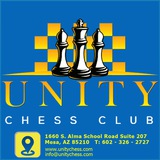19...Nh5 20.Ne4 Bxe4 21.Bxe4 dxe5 22.fxe5 leads to a large advantage for White – White can cripple the knight on g7 with g2-g4!.
White uses the same idea as in the game after the preliminary exchange 19...dxe5 20.fxe5 Nd7 21.Be4!. After the exchange of bishops, the white knight breaks into the black position with great effect, whilst after 21...Bc8, White carries out a nice attack: 22.Nd5! exd5 23.Bxd5 Bf6 24.e6! fxe6 25.Bxe6+ Kg7 26.Rxd7+!, mating.
White uses the same idea as in the game after the preliminary exchange 19...dxe5 20.fxe5 Nd7 21.Be4!. After the exchange of bishops, the white knight breaks into the black position with great effect, whilst after 21...Bc8, White carries out a nice attack: 22.Nd5! exd5 23.Bxd5 Bf6 24.e6! fxe6 25.Bxe6+ Kg7 26.Rxd7+!, mating.
By neutralising the enemy light-squared bishop, White ensures his pieces greater room for manoeuvre.
Otherwise, the white knight comes to e4, but now White exploits the greater weakening of the black kingside:
Unity Chess Club
Pal Benko Mikhail Tal Bled/Zagreb/Belgrade 1959 Black to move
The squares around the white king are weak, and without wasting any time on preparation, Black breaks through to them, saving an important tempo on the preparatory move ...g6-g5.
Other replies also offer no chance of salvation:
26.gxf4 Qh4 27.Qxd6 Bh3 28.f5 Rxf5;
26.exf4 e3!;
26.Ne2 fxg3 27.hxg3 Qf6 28.Be1 g5!, with the threat ...Qf6-f3 and ...Bc8-h3.
26.gxf4 Qh4 27.Qxd6 Bh3 28.f5 Rxf5;
26.exf4 e3!;
26.Ne2 fxg3 27.hxg3 Qf6 28.Be1 g5!, with the threat ...Qf6-f3 and ...Bc8-h3.
Unity Chess Club
Lev Polugaevsky 2620 Lubomir Ftacnik 2475 Luzern ol 1982 Black to move
White’s set-up looks rather suspicious – his Ra1 should be on c1 or f1. In addition, White’s other pieces are not pointing at the kingside, so the Bb2 is not very effectively placed. Black lands a couple of mighty blows against the rather scattered white forces:
For the moment, White is a pawn up, but his position collapses, due to the lack of supports.
